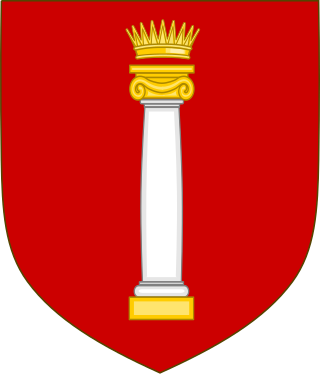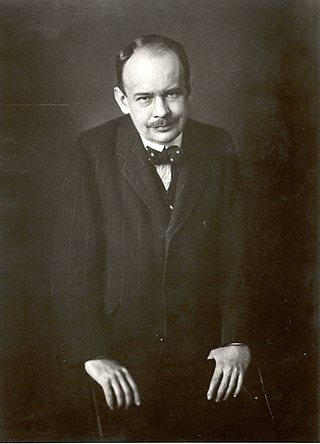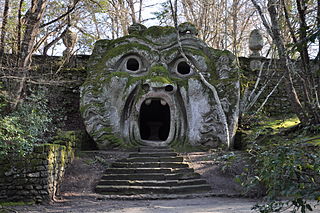Related Research Articles

The House of Colonna, also known as Sciarrillo or Sciarra, is an Italian noble family, forming part of the papal nobility. It was powerful in medieval and Renaissance Rome, supplying one pope and many other church and political leaders. The family is notable for its bitter feud with the Orsini family over influence in Rome, until it was stopped by papal bull in 1511. In 1571, the heads of both families married nieces of Pope Sixtus V. Thereafter, historians recorded that "no peace had been concluded between the princes of Christendom, in which they had not been included by name".

Max Dvořák was a Czech-born Austrian art historian. He was a professor of art history at the University of Vienna and a famous member of the Vienna School of Art History, employing a Geistesgeschichte methodology.

The Treaty of Templin was concluded on 24/25 November 1317, ending a war between the Margraviate of Brandenburg and Denmark, the latter leading a North German alliance. During this war, Brandenburgian margrave Waldemar and his troops were decisively defeated in the 1316 Battle of Gransee, fought at Schulzendorf between Rheinsberg and Gransee. After the battle, Brandenburg was forced to negotiate a truce. The treaty of Templin was signed a year later by Danish king Eric VI Menved, his ally duke Henry II of Mecklenburg, and Waldemar.

The Sacro Bosco, colloquially called Park of the Monsters, also named Garden of Bomarzo, is a Mannerist monumental complex located in Bomarzo, in the province of Viterbo, in northern Lazio, Italy.
Ludwig Heinrich Heydenreich was a German art historian specialized in Italian Renaissance art. From 1947 to 1970, he served as director of the Zentralinstitut für Kunstgeschichte, Munich.
The Zentralinstitut für Kunstgeschichte, is an independent art-historical research institute in Germany. The institute resides in the former administration building of the National Socialist party near Königsplatz in Munich.
Wolfgang Lotz was a German art historian specialized in Italian Renaissance architecture.

Willibald Sauerländer was a German art historian specializing in Medieval French sculpture. From 1970 to 1989, he was director of the prestigious Zentralinstitut für Kunstgeschichte, Munich.
Hans Jantzen was a German art historian who specialized in Medieval art.
Herbert von Einem was a German art historian.
Giovan Antonio Rusconi was a Venetian architect, hydraulic engineer, translator and illustrator of Vitruvius.

Livio Retti was an Italian Baroque painter who worked mainly in present-day South Germany, at the time the Duchy of Württemberg, the Duchy of Bavaria, some secular or ecclesiastical Franconian principalities and some free imperial cities such as Schwäbisch Hall.
Iris Lauterbach is a German art historian with the Zentralinstitut für Kunstgeschichte. She is a specialist in the history of gardens in art and was a co-founder of the network for German orangeries, the international history of art network, and the German historical gardens circle for the art of gardens and landscape culture. She has been an honorary professor at the Technical University of Munich since 2012.
Ulrich Pfisterer is a German art historian whose scholarship focuses on the art of Renaissance Italy. He is currently a professor of art history at Ludwig Maximilian University of Munich and the director of the Zentralinstitut für Kunstgeschichte.
Peter Herde is a German historian. His research activities range from fundamental work on papal diplomatics of the Middle Ages to the history of the country up to the Second World War.
Reinhard Liess is a German art historian.
Robert Suckale was a German art historian, medievalist and professor at Technische Universität Berlin.
Benno Geiger was an Austrian art historian, art dealer, writer and translator, and member of the Nazi Party.
Kathrin Hoffmann-Curtius was a German, independent art historian, who taught for a time at the universities of Tübingen, Hamburg, Trier and Vienna.
The Liber colorum secundum magistrum Bernardum is a medieval treatise on miniature painting and book illumination. Written in a Medieval Latin interspersed with several expressions in the Italian Lombard dialect it stems from 13th century Northern Italy. The eponymous magister Bernardus was most likely a cleric working in a scriptorium to whom later collections also attribute further artisanal instructions not related to book painting. It is contained within four manuscripts:
References
- ↑ Cf. the homepage of the Germanistischen Seminar at Heidelberg University; there under IV. Habilitationen und Promotionen, b 23.
- ↑ Cf. the alumni lists of the Centro Tedesco and of the Zentralinstitut für Kunstgeschichte with description of the project.
- ↑ In the festival programme; the Austrian public broadcaster’s (ORF) announcement.
- ↑ Homepage of the Casa di Goethe and Borsa di Studio. Karin und Uwe Hollweg Stiftung. Stipendium Casa di Goethe Rom 2013-2020. Ed. by Maria Gazzetti and Claudia Nordhoff, Rome 2022, pp. 62-65; Reiser/Travaglio 2023, front matter.
- ↑ Cf. the publisher’s press release.
- ↑ Cf. Gerda Henkel Stiftung. Jahresbericht 2016, p. 80; project description in the Volkswagen Foundation's database; his institute’s former members’ list; and Borsa di Studio 2022, p. 65; Durham Collections Fellowships, Meet Our Fellows; there under 2023/24, June.
- ↑ Reviewed by Annemarie Bucher, in: Topiaria Helvetica (2015), p. 93; Luisa Leesemann, in: Mittellateinisches Jahrbuch 1/3 (2016), pp. 472-475; Franziska Meier, in: Journal für Kunstgeschichte 19 (2015), pp. 336-341; Christoph Pieper, in: IASL online 17 December 2015; Wolfgang Schweickard, in: Zeitschrift für romanische Philologie 130, 2014, pp. 1212sq.
- ↑ Reviewed by Didier Kahn, in: Arbitrium 33 (2015), pp. 63-66; Fredericka A. Schmadel, in: Journal of Folklore Research (online) 4 October 2011.